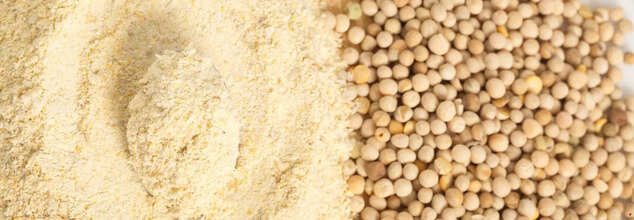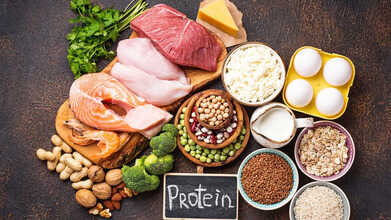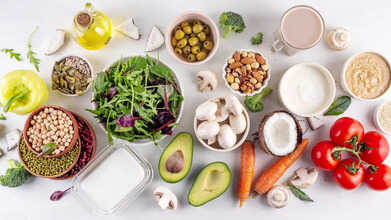- Health Conditions A-Z
- Health & Wellness
- Nutrition
- Fitness
- Health News
- Ayurveda
- Videos
- Medicine A-Z
- Parenting
Can Pea Protein Help You Gain Muscle?

Pea Protein (Credit: Canva)
Protein supplements, whether animal or plant-based, are the most consumed product in the fitness world. Pea protein powder is one of the star products that is a protein supplement extracted from yellow peas. This plant-based protein is known for its dense nutritional profile, versatility, and capability to be included in multiple diets, it supports muscle growth, weight management, and heart health.
How Is Pea Protein Powder Created?
Pea protein powder is typically made by isolating protein from yellow peas, resulting in a nutrient-dense beige powder. A standard serving, such as two scoops (20 grams) of organic pea protein powder contains 15 grams of proteins while giving out 80 calories. It has 1 gram of carbs, 1 gram of fiber, 1.5 grams of total fat, 230 mg of sodium and 5mg of iron. Notably, it is rich in branched-chain amino acids (BCAAs) like leucine, isoleucine, and valine, which support muscle repair and growth but is slightly lower in methionine, an essential amino acid, which can be supplemented with foods like eggs, fish, or brown rice.
Health Benefits Of Pea Powder Range From Weight Loss To Muscle Building
Pea protein powder is widely used by those trying to build muscles. A study has shown comparable efficacy to whey protein in promoting muscle growth when paired with resistance training. A 12-week study found that participants consuming 50 grams of pea protein daily experienced muscle gains similar to those taking whey protein.
It is also known to enhance satiety in people. This eventually stops you from consuming more calories and supporting gradual weight loss. Studies indicate that pea protein promotes fullness as effectively as dairy-based proteins like casein and whey.
Moreover, research conducted on animals have shown that pea protein can lower risk factors for heart disease, such as high blood pressure and cholesterol. Pea protein hydrolysate—a partially digested form—has demonstrated significant blood pressure reduction in animal trials. While these findings are promising, further research is needed in humans.
While pea protein is high in iron, it must be noted that plant-based iron is less absorbable than animal-derived iron. Thus, pairing it with vitamin C-rich foods, such as citrus fruits, can enhance absorption by up to 67%.
Pea protein is vegan, gluten-free, dairy-free, and hypoallergenic, making it suitable for most diets. Its smooth texture and mild flavour blend easily into water, juices, or smoothies without the grittiness often associated with plant-based proteins.
While we continue to delve into the health benefits of proteins, the question is should you consume protein powders?
For this first we must delve into the details of protein powders and understand the difference between whey and plant-based proteins. Protein powders are concentrated sources of protein derived from either plant-based sources like soybeans, peas, peanuts, and rice, or animal-based sources such as milk (including casein and whey proteins). The manufacturing processes vary depending on the type of protein. For example, whey protein is derived from cow's milk, which consists of approximately 20% whey (the liquid left over after milk is curdled and strained) and 80% casein (a milk protein used as an emulsifier).
The Diet That Changed Lionel Messi: The Five Foods That Power The Footballer At 38

Credits: Instagram
Lionel Messi is here in India and is ready for his touch down in Delhi on December 15 as part of his GOAT (Greatest of All Time) Tour's India visit. Argentina's World Cup-winning captain is also set to visit Hyderabad after his visit in Delhi, for now, he has met his fans in Mumbai and Kolkata. All things said and done, what every one is always curious about is a sports person's fitness regime. The 38-year-old football star undergoes a strict fitness regime, which includes consistency, but it is not based on heavy lifting, but agility training, and a simple not-too-fancy diet.
However, his fitness journey was not traditional in any manner. In fact, during his early years, he was known for eating without much of a thought. So, what changed him? What is his secret to a fit life?
How Messi Changed His Eating Habits To Stay Fit
In 2013-14 World Cup, which was disappointing for Messi, ESPN India reported that Messi improved his performance by adapting a new diet. Charly Rexach, the then FC Barcelona's sporting director, who signed the then 13-year-old Messi to the club in 2000 on a napkin, said that Messi had previously "eaten too many pizzas".
In an interview to America TV's La Cornisa, Messi admitted about his eating habits and poor diet, which had even led to bouts of vomiting, nausea, and even lethargy. The footballer said, "I don't know what I ate, but I ate badly for many years. At 22, 23...[it was] chocolate, alfajores [South American sandwich cookies], fizzy drinks."
It was nutritionist Giuliano Poser who helped Messi make changes in 2014. His diet was nothing fancy, nothing too difficult, but it was controlled.
Five Pillars Of Messi's New Diet
Messi's new diet was based on five pillars:
- Water
- Olive oil
- Whole grains
- Fruits
- Vegetables
Messi also shared in an interview, "Now I eat well: fish, meat, vegetables, salads. Everything is organized and taken care of. Sometimes a bit of wine, but that's not a problem."
This diet helped him reduce inflammation and recover his muscles faster. When it came to avoiding certain foods Poser stressed the importance of eating little sugar and refined flour. Poser called these two "the worst thing for the muscles". "The farther he stays away from sugars, the better. Refined flours are also a big problem as these days, it’s difficult to find uncontaminated wheat.”
Water
Studies published in the Journal of Athletic Training and Journal of Physical Therapy Science, show that dehydration increases markers of muscle damage and inflammation after exercise. Research also notes that adequate hydration supports blood flow and nutrient delivery, which are essential for muscle repair.
Olive oil
Research in Nature and the Journal of Nutritional Biochemistry highlights that extra virgin olive oil contains oleocanthal and polyphenols, compounds shown to have anti-inflammatory effects similar to mild anti-inflammatory drugs, helping reduce muscle soreness and inflammation.
Whole grains
According to studies in the American Journal of Clinical Nutrition, whole-grain intake is associated with lower levels of C-reactive protein, a key marker of inflammation. Their complex carbohydrates and magnesium content support muscle function and recovery after physical activity.
Fruits
Research published in Nutrients and Sports Medicine shows that antioxidant-rich fruits like berries and citrus help reduce oxidative stress caused by exercise, which can otherwise delay muscle recovery and increase inflammation.
Vegetables
Large observational studies, including reports in The BMJ, link high vegetable intake with reduced systemic inflammation. Their vitamins, minerals, and phytochemicals support immune response and tissue repair, aiding post-exercise muscle recovery.
What Does Messi's Workout Regime Look Like? 3s Of Messi's Fitness
As per reports, Messi's training is not as rigorous as players like Neymar and Cristiano Ronaldo, but it does not mean that there is not consistency. In fact, his primary training focuses on three factors:
- Speed
- Strength
- Stretching
The footballer’s fitness does not come from heavy weightlifting. Instead, it is built on a balanced routine that focuses on strength training, agility, speed, extensive stretching, and overall muscle health. His workouts include short, explosive sprints, bounding drills like hurdle hops and pillar skips, all aimed at keeping his body sharp, responsive, and match-ready.
Taking Mounjaro For Weight Loss? Doctor Warns Why Protein Intake Is Non-Negotiable

Credits: Canva
Mounjaro has reshaped weight-loss journeys by powerfully reducing appetite, but doctors are now flagging an important concern. Dr Hasia, who recently addressed this on her Instagram, explained that when food intake drops sharply on Mounjaro, protein intake often falls with it. The result is weight loss that may include muscle, not just fat.
How Mounjaro’s Appetite Suppression Affects Muscle
Mounjaro works by influencing hormones that control hunger and blood sugar, helping people feel full faster and eat less. Dr Hasia notes that while this is effective for fat loss, it can quietly lead to muscle breakdown if protein is not prioritised. When protein is low, the body turns to muscle tissue for essential amino acids, weakening the body over time.
The Protein Rule Dr Hasia Recommends on Mounjaro
In her Instagram post, Dr Hasia shared a simple guideline for those using Mounjaro. Aim for 1.0 to 1.5 grams of protein per kilogram of body weight each day. For example, a person weighing 70 kilograms should target roughly 70 to 100 grams of protein daily. This amount supports muscle preservation even when overall calories are reduced.
Why Protein on Mounjaro Protects Metabolism
Muscle plays a major role in keeping metabolism active. Dr Hasia explains that losing muscle on Mounjaro can slow metabolic rate, making long-term weight maintenance harder. Adequate protein helps preserve lean mass, which keeps calorie burning steady and reduces the risk of fatigue during weight loss.How Protein on Mounjaro Supports Skin and Strength
Rapid weight loss can sometimes lead to sagging skin and weakness. According to Dr Hasia, protein supports collagen production, which helps maintain skin firmness. It also preserves strength, making day-to-day activities easier and reducing the sense of physical depletion some people report while on Mounjaro.
Easy Protein Meals to Tolerate on Mounjaro
Because appetite is often low on Mounjaro, Dr Hasia suggests choosing protein foods that feel light and manageable. Greek yogurt with chia seeds works well for breakfast. Smoothies with almond milk and a scoop of whey or collagen are often easier than solid meals. Lunch or dinner can include grilled salmon, chicken, eggs, or tofu with vegetables and healthy fats.Smart Protein Snacks While Using Mounjaro
On days when full meals feel difficult, Dr Hasia recommends small protein-rich snacks. Boiled eggs, edamame, tuna cups, cottage cheese, or a simple protein bar can help meet daily needs without overwhelming the stomach. These options make it easier to stay consistent.
How to Space Protein Intake on Mounjaro
Dr Hasia also highlights the importance of spreading protein throughout the day. Instead of eating it all at once, aiming for 20 to 30 grams per meal allows better absorption and ongoing muscle support. On Mounjaro, consistency matters more than portion size.
Protein, as Dr Hasia reminds her followers, is not an extra on Mounjaro. It is a foundation. Protecting muscle now helps protect metabolism
Vegan Children Are Shorter And Skinnier Than Meat-Eaters, Nutritionists Raise Concern

Credits: Canva
Children following vegan and vegetarian diets may be missing key nutrients, according to a group of international researchers who shared their findings on Friday.
Plant-based eating has long been linked with lower risks of heart disease and stronger immunity. Yet a new peer-reviewed study, the largest of its kind, analysed 48,000 children and adolescents and found that vegetarian kids were consuming fewer calories, less protein and fat, and lower amounts of important nutrients like zinc and vitamin B12, which supports the nervous system. Vegan children showed similar patterns, with a particularly noticeable lack of calcium, which is vital for bone health.
Vegan Children Are Shorter And Skinnier Than Meat-Eaters
“Vitamin B12 rarely reaches adequate levels without supplementation or fortified foods, and calcium, iodine, and zinc are often at the lower end of recommended intake, making them critical nutrients for kids on plant-based diets,” said Dr. Jeannette Beasley, associate professor at New York University and one of the study’s authors.
The research reviewed 59 studies across 18 countries, comparing nutritional outcomes among 7,280 vegetarians, 1,289 vegans, and 40,059 children who ate both plants and meat (omnivores).
A Boost To Heart Health
While the study highlighted potential nutrient gaps in plant-based diets, it also showed benefits. Vegetarian children consumed more fibre, iron, folate, and vitamin C than omnivores, and both vegan and vegetarian children showed healthier hearts.
They had lower levels of LDL cholesterol, the “bad” cholesterol that can clog arteries and increase the risk of heart attacks and strokes later in life.
“The more animal products replace whole plant foods in the diet, the worse cardiovascular health tends to be,” said Dr. Dana Hunnes, senior dietitian at Ronald Reagan UCLA Medical Center, who was not involved in the study, as per The Independent.
Vegan and vegetarian children were also shorter and had a lower body mass index than meat-eaters, which may reduce the risk of obesity and diabetes—conditions that can further impact heart health.
Small Snacks, Big Difference
Although plant-based diets may leave gaps in nutrients like B12 or zinc, careful planning can help children meet their needs.
While animal products are naturally higher in zinc, lentils, pumpkin seeds, and cashews are excellent plant-based sources, with cashews providing nearly eight grams of zinc per cup. These can be eaten as snacks, added to soups, or blended into smoothies.
For vitamin B12, plant-based children can include seaweed or shiitake mushrooms in their diet. A 100-gram serving of shiitake mushrooms contains about 5.6 micrograms of B12.
According to Stanford Medicine, children should get between three and 11 milligrams of zinc depending on age, and between 0.9 and 2.4 micrograms of vitamin B12.
“Our findings suggest a balanced approach is key, with families ensuring kids get enough of vitamin B12, calcium, iodine, iron, and zinc to grow and thrive,” said Dr. Wolfgang Marx, co-author and senior research fellow at Deakin University in Australia.
© 2024 Bennett, Coleman & Company Limited

